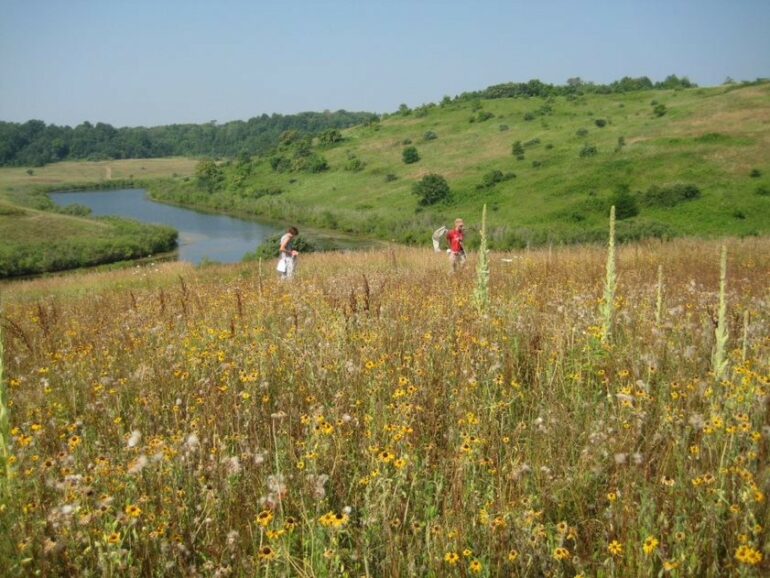When it comes to establishing prairies that support pollinators on reclaimed industrial land, a new study suggests native plant diversity matters less than seeding species with the ability to persist in poor soils.
Researchers found that flowering plants hardy enough to blossom and survive in about 6 inches of topsoil—including some non-native plants—were the best ecological bet for unmanaged plots designed to provide habitat for bees, butterflies, wasps and other pollinators for the long term.
The study produced a rare 10-year dataset on pollinator habitat plot experiments that Ohio State University scientists conducted at The Wilds, a conservation center in southeast Ohio located on the site of a former coal strip-mining operation.
As a group, the dozens of plots lost more than 75 percent of flowers over a decade, but the quality of the plantings stabilized after six years to provide a full season of blooms that were accessed by at least 120 species of bees. If the researchers hadn’t kept monitoring for a full 10 years, they would have finished the study with vastly different conclusions about what works—and what doesn’t.
“If you’re only monitoring a planting for three years, you’re going to overestimate how good that is in the long run. Between years four and six we had a massive decline in the abundance of flowers,” said Karen Goodell, senior author of the study and a professor of evolution, ecology and organismal biology at Ohio State Newark.
“On the other hand, some species stuck around. You need to plan to have flowers at the beginning, but you also need to plant species that might take a few years to get going and are going to last as long as a decade.”
The study is published in the January 2022 issue of the journal Ecological Applications.
Research shows that approximately one of every three bites of food we take is pollinated by bees—but bees and other pollinators are on a decline, to different degrees and for different reasons depending on the species.
Concern about that loss has prompted public and private efforts to support pollinators with widespread plantings of wildflowers in such settings as roadsides, garbage dumps and reclaimed mines. To be successful, these unmanaged plots need to be seeded with plants that have staying power, this research suggests.
In 2009, Goodell sowed native prairie wildflower seeds in 48 plots at The Wilds with one of three mixes—some with nine species and others with 18—to test whether the quality of the floral community over time depended on the diversity or the composition of the species planted. Aside from occasional mowing around each plot, the plants were left alone.
“We were astonished to find a greater than 75 percent decline in flower abundance and loss of more than half of the species over 10 years,” Goodell said. “We played with species diversity, with some plots having more species than others. That had almost no impact on overall flower diversity after 10 years—time was the major factor that influenced what was growing in the plots.
“Some species we picked to plant are native and attractive to bees, but don’t do very well under the harsh field conditions. They were not competitive. Some stayed at very low density or just couldn’t make it.”
That said, the plots did remain useful to pollinators by producing flowers from early spring through the fall. Annuals provided early spring flowers for the first two years before they disappeared, giving way to perennials. Volunteer non-native species later became the most reliable at providing early spring blooms—with native species “ramping up over the growing season and blooming into the fall,” Goodell said.
The contributions of non-native species were key to providing resources for bees across the season, she said, despite their potential to crowd out their native neighbors. Non-native species have been favored in mine land reclamation because they can grow quickly on soils that lack nutrients. More work needs to be done to find non-invasive, native alternatives with fewer ecological risks.
The paper contains a detailed table of the species originally planted and how they fared. Highly persistent—though gradual in becoming abundant—planted native perennials in the study included black-eyed Susans, wild bergamot, foxglove, Chinese witch hazel, rough oxeye and pitcher sage. Two native volunteers also stood out for their abundance: wild basil and Erigeron annuus, a member of the daisy family.
Through this work and a related study exploring which species of plants are visited and preferred by different types of pollinators, Goodell hopes to help guide species selection for future pollinator habitat restorations.
“We’ve learned valuable lessons that we haven’t gotten from other studies of pollinator habitats,” she said.
More information:
Andrew H. Lybbert et al, Ten‐year trends reveal declining quality of seeded pollinator habitat on reclaimed mines regardless of seed mix diversity, Ecological Applications (2021). DOI: 10.1002/eap.2467
Provided by
The Ohio State University
Citation:
Sowing pollinator habitat seeds that grow where they’re planted (2022, February 4)



